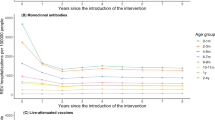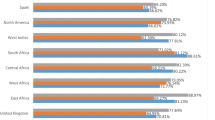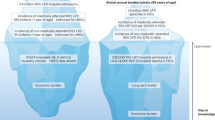Abstract
Respiratory syncytial virus (RSV) is a leading cause of hospitalization in infants. A formalin-inactivated RSV vaccine was used to immunize children and elicited nonprotective, pathogenic antibody. Immunized infants experienced increased morbidity after subsequent RSV exposure. No vaccine has been licensed since that time. A widely accepted hypothesis attributed the vaccine failure to formalin disruption of protective antigens. Here we show that the lack of protection was not due to alterations caused by formalin but instead to low antibody avidity for protective epitopes. Lack of antibody affinity maturation followed poor Toll-like receptor (TLR) stimulation. This study explains why the inactivated RSV vaccine did not protect the children and consequently led to severe disease, hampering vaccine development for 42 years. It also suggests that inactivated RSV vaccines may be rendered safe and effective by inclusion of TLR agonists in their formulation, and it identifies affinity maturation as a key factor for the safe immunization of infants.
This is a preview of subscription content, access via your institution
Access options
Subscribe to this journal
Receive 12 print issues and online access
$259.00 per year
only $21.58 per issue
Buy this article
- Purchase on SpringerLink
- Instant access to full article PDF
Prices may be subject to local taxes which are calculated during checkout






Similar content being viewed by others
References
Collins, P.L. et al. Fields Virology. (eds. Knipe, D.M. & Howley, P.M.) 1443–1486 (Raven Press, New York, 2001).
Glezen, W.P., Taber, L.H., Frank, A.L. & Kasel, J.A. Risk of primary infection and reinfection with respiratory syncytial virus. Am. J. Dis. Child. 140, 543–546 (1986).
Shay, D.K. et al. Bronchiolitis-associated hospitalizations among US children, 1980–1996. J. Am. Med. Assoc. 282, 1440–1446 (1999).
Kim, H.W. et al. Respiratory Ssyncytial virus disease in infants despite prior administration of antigenic inactivated vaccine. Am. J. Epidemiol. 89, 422–434 (1969).
Polack, F.P. et al. A role for immune complexes in enhanced respiratory syncytial virus disease. J. Exp. Med. 196, 859–865 (2002).
Graham, B.S. et al. Priming immunization determines T helper cytokine mRNA expression patterns in lungs of mice challenged with respiratory syncytial virus. J. Immunol. 151, 2032–2040 (1993).
Moghaddam, A. et al. A potential molecular mechanism for hypersensitivity caused by formalin-inactivated vaccines. Nat. Med. 12, 905–907 (2006).
Srikiatkhachorn, A. & Braciale, T.J. Virus-specific CD8+ T lymphocytes downregulate T helper cell type 2 cytokine secretion and pulmonary eosinophilia during experimental murine respiratory syncytial virus infection. J. Exp. Med. 186, 421–432 (1997).
Connors, M. et al. Pulmonary histopathology induced by respiratory syncytial virus (RSV) challenge of formalin-inactivated RSV-immunized BALB/c mice is abrogated by depletion of CD4+ T cells. J. Virol. 66, 7444–7451 (1992).
Connors, M. et al. Enhanced pulmonary histopathology induced by respiratory syncytial virus (RSV) challenge of formalin-inactivated RSV-immunized BALB/c mice is abrogated by depletion of interleukin-4 (IL-4) and IL-10. J. Virol. 68, 5321–5325 (1994).
Connors, M. et al. Cotton rats previously immunized with a chimeric RSV FG glycoprotein develop enhanced pulmonary pathology when infected with RSV, a phenomenon not encountered following immunization with vaccinia-RSV recombinants or RSV. Vaccine 10, 475–484 (1992).
Murphy, B.R., Sotnikov, A.V., Lawrence, L.A., Banks, S.M. & Prince, G.A. Enhanced pulmonary histopathology is observed in cotton rats immunized with formalin-inactivated respiratory syncytial virus (RSV) or purified F glycoprotein and challenged with RSV 3–6 months after immunization. Vaccine 8, 497–502 (1990).
Murphy, B.R. & Walsh, E.E. Formalin-inactivated respiratory syncytial virus vaccine induces antibodies to the fusion glycoprotein that are deficient in fusion-inhibiting activity. J. Clin. Microbiol. 26, 1595–1597 (1988).
Prince, G.A. et al. Enhancement of respiratory syncytial virus pulmonary pathology in cotton rats by prior intramuscular inoculation of formalin-inactivated virus. J. Virol. 57, 721–728 (1986).
Wu, H. et al. Development of motavizumab, an ultra-potent antibody for the prevention of respiratory syncytial virus infection in the upper and lower respiratory tract. J. Mol. Biol. 368, 652–665 (2007).
Johnson, S. et al. A direct comparison of the activities of two humanized respiratory syncytial virus monoclonal antibodies: MEDI-493 and RSHZl9. J. Infect. Dis. 180, 35–40 (1999).
American Academy of Pediatrics Committee on Infectious Diseases and Committee on Fetus and Newborn. Revised indications for the use of palivizumab and respiratory syncytial virus immune globulin intravenous for the prevention of respiratory syncytial virus infections. Pediatrics 112, 1442–1446 (2003).
Graham, B.S. et al. Role of T lymphocyte subsets in the pathogenesis of primary infection and rechallenge with respiratory syncytial virus in mice. J. Clin. Invest. 88, 1026–1033 (1991).
Murphy, B.R. et al. Immunization of cotton rats with the fusion (F) and large G) glycoproteins of respiratory syncytial virus ( (RSV) protects against RSV challenge without potentiating RSV disease. Vaccine 7, 533–540 (1989).
Mapletoft, J.W. et al. Intranasal immunization of mice with a formalin-inactivated bovine respiratory syncytial virus vaccine co-formulated with CpG oligodeoxynucleotides and polyphosphazenes results in enhanced protection. J. Gen. Virol. 89, 250–260 (2008).
Polack, F.P., Hoffman, S.J., Crujeiras, G. & Griffin, D.E. A role for nonprotective complement-fixing antibodies with low avidity for measles virus in atypical measles. Nat. Med. 9, 1209–1213 (2003).
Bachmann, M.F. et al. The role of antibody concentration and avidity in antiviral protection. Science 276, 2024–2027 (1997).
Fleury, D. et al. A complex of influenza hemagglutinin with a neutralizing antibody that binds outside the virus receptor binding site. Nat. Struct. Biol. 6, 530–534 (1999).
Arbiza, J. et al. Characterization of two antigenic sites recognized by neutralizing monoclonal antibodies directed against the fusion glycoprotein of human respiratory syncytial virus. J. Gen. Virol. 73, 2225–2234 (1992).
Melendi, G.A. et al. C5 modulates airway hyperreactivity and pulmonary eosinophilia during enhanced respiratory syncytial virus disease by decreasing C3a receptor expression. J. Virol. 81, 991–999 (2007).
Medzhitov, R. Toll-like receptors and innate immunity. Nat. Rev. Immunol. 1, 135–145 (2001).
Pasare, C. & Medzhitov, R. Control of B-cell responses by Toll-like receptors. Nature 438, 364–368 (2005).
Rudd, B.D. et al. Type I interferon regulates respiratory virus infected dendritic cell maturation and cytokine production. Viral Immunol. 20, 531–540 (2007).
Rudd, B.D. et al. MyD88-mediated instructive signals in dendritic cells regulate pulmonary immune responses during respiratory virus infection. J. Immunol. 178, 5820–5827 (2007).
Smit, J.J. et al. The balance between plasmacytoid DC versus conventional DC determines pulmonary immunity to virus infections. PLoS ONE 3, e1720 (2008).
Polack, F.P. et al. The cysteine-rich region of respiratory syncytial virus attachment protein inhibits innate immunity elicited by the virus and endotoxin. Proc. Natl. Acad. Sci. USA 102, 8996–9001 (2005).
Kawai, T., Adachi, O., Ogawa, T., Takeda, K. & Akira, S. Unresponsiveness of MyD88-deficient mice to endotoxin. Immunity 11, 115–122 (1999).
Kurt-Jones, E.A. et al. Pattern recognition receptors TLR4 and CD14 mediate response to respiratory syncytial virus. Nat. Immunol. 1, 398–401 (2000).
Rudd, B.D. et al. Deletion of TLR3 alters the pulmonary immune environment and mucus production during respiratory syncytial virus infection. J. Immunol. 176, 1937–1942 (2006).
Lindemans, C.A. et al. Respiratory syncytial virus inhibits granulocyte apoptosis through a phosphatidylinositol 3-kinase and NF-κB–dependent mechanism. J. Immunol. 176, 5529–5537 (2006).
Gavin, A.L. et al. Adjuvant-enhanced antibody responses in the absence of Toll-like receptor signaling. Science 314, 1936–1938 (2006).
Kool, M. et al. Cutting Edge: alum adjuvant stimulates inflammatory dendritic cells through activation of the NALP3 inflammasome. J. Immunol. 181, 3755–3759 (2008).
Polack, F.P. et al. Production of atypical measles in rhesus macaques: evidence for disease mediated by immune complex formation and eosinophils in the presence of fusion-inhibiting antibody. Nat. Med. 5, 629–634 (1999).
Brokstad, K.A. et al. Cross-reaction but no avidity change of the serum antibody response after influenza vaccination. Vaccine 13, 1522–1528 (1995).
Knossow, M. et al. Mechanism of neutralization of influenza virus infectivity by antibodies. Virology 302, 294–298 (2002).
Barbey-Martin, C. et al. An antibody that prevents the hemagglutinin low pH fusogenic transition. Virology 294, 70–74 (2002).
Sauter, N.K. et al. Hemagglutinins from two influenza virus variants bind to sialic acid derivatives with millimolar dissociation constants: a 500-MHz proton nuclear magnetic resonance study. Biochemistry 28, 8388–8396 (1989).
Kolokoltsov, A.A. et al. Small interfering RNA profiling reveals key role of clathrin-mediated endocytosis and early endosome formation for infection by respiratory syncytial virus. J. Virol. 81, 7786–7800 (2007).
Liu, P. et al. Retinoic acid-inducible gene I mediates early antiviral response and Toll-like receptor 3 expression in respiratory syncytial virus–infected airway epithelial cells. J. Virol. 81, 1401–1411 (2007).
Bhoj, V.G. et al. MAVS and MyD88 are essential for innate immunity but not cytotoxic T lymphocyte response against respiratory syncytial virus. Proc. Natl. Acad. Sci. USA 105, 14046–14051 (2008).
Hussell, T., Baldwin, C.J., O'Garra, A. & Openshaw, P.J. CD8+ T cells control TH2-driven pathology during pulmonary respiratory syncytial virus infection. Eur. J. Immunol. 27, 3341–3349 (1997).
Neuzil, K.M. et al. Adjuvants influence the quantitative and qualitative immune response in BALB/c mice immunized with respiratory syncytial virus FG subunit vaccine. Vaccine 15, 525–532 (1997).
García-Barreno, B. et al. Marked differences in the antigenic structure of human respiratory syncytial virus F and G glycoproteins. J. Virol. 63, 925–932 (1989).
Acknowledgements
PFP was a generous gift from V. Randolph (Wyeth Lederle) and Gk2.43 monoclonal antibody for CD8+ T lymphocyte depletion was generously provided by B. Graham and T. Johnson (National Institute of Allergy and Infectious Diseases, US National Institutes of Health). We thank M. del Carmen Puggioli for excellent technical assistance. This work was supported by AI-054952 (F.P.P.) and the Thomas and Carol McCann Innovative Research Fund for Asthma and Respiratory Diseases (F.P.P.). M.F.D., A.C.M., J.P.B. and S.C. are recipients of Doctoral Awards from the Consejo Nacional de Investigaciones Científicas y Técnicas, Argentina. G.A.M. is a recipient of the Thrasher Research Fund Early Career Award.
Author information
Authors and Affiliations
Contributions
M.F.D., S.C., A.C.M., G.A.M., J.Z.H., J.P.B., L.D., A.T. and H.-Y.C. performed research; J.R., J.A.M. and W.M. contributed new reagents and/or analytic tools; M.F.D., W.M., J.A.M., J.P.B., P.M.I. and F.P.P. analyzed data; F.P.P. designed research; M.F.D., P.M.I. and F.P.P. wrote the paper.
Corresponding author
Supplementary information
Supplementary Text and Figures
Supplementary Figs. 1–5 and Supplementary Methods (PDF 302 kb)
Rights and permissions
About this article
Cite this article
Delgado, M., Coviello, S., Monsalvo, A. et al. Lack of antibody affinity maturation due to poor Toll-like receptor stimulation leads to enhanced respiratory syncytial virus disease. Nat Med 15, 34–41 (2009). https://doi.org/10.1038/nm.1894
Received:
Accepted:
Published:
Issue date:
DOI: https://doi.org/10.1038/nm.1894
This article is cited by
-
Efficacy of H2O2 inactivated bovine virus diarrhoea virus (BVDV) type 1 vaccine in mice
BMC Veterinary Research (2024)
-
ChAd155-RSV vaccine is immunogenic and efficacious against bovine RSV infection-induced disease in young calves
Nature Communications (2022)
-
CAF08 adjuvant enables single dose protection against respiratory syncytial virus infection in murine newborns
Nature Communications (2022)
-
B cells oppose Mycoplasma pneumoniae vaccine enhanced disease and limit bacterial colonization of the lungs
npj Vaccines (2022)
-
Immunoprophylactic properties of the Corynebacterium pseudotuberculosis-derived MBP:PLD:CP40 fusion protein
Applied Microbiology and Biotechnology (2022)



